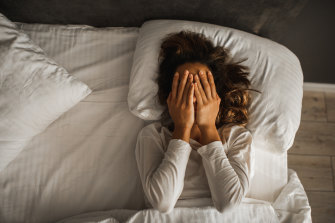Examine, a weekly newsletter covering the latest developments in science, is sent every Tuesday. Below is an excerpt – sign up to get the whole newsletter in your inbox.
Every night, as our heavy heads finally hit the pillow, and we waft into sleep, our brains pull up a chair and apply a microscope to our innermost thoughts.
The pandemic changed the way many of us sleep and dream.Credit:Getty
Much like a therapist, the brain picks apart our day — narrowing in on the details that irritated or enticed us — and often, it goes back further, into the wound of an old, painful memory.
It’s here, in the expansive world of our subconscious, that our brains do more work than we realise. (EEG tests show that our brain activity during rapid eye movement (REM) sleep is similar during wakefulness.)
Dreaming is a highly adaptive process with an important function: by simulating our waking life, our dreams force us to reckon with our challenges and emotions. This helps to ease the sting of a traumatic experience, leaving us more resolved when we wake.
This sophisticated level of emotional processing explains why, at times of crisis throughout history, such as earthquakes, wars and terrorist attacks, studies show that our dreams have tended to change, and nightmares become more frequent.
So, how did a once-in-a-lifetime pandemic play out in our dreams and sleep patterns?
Many of us toughing it out during lockdowns at home, while juggling work and childbearing responsibilities, may have had more trouble sleeping and frightful dreams. I, for one, certainly did. But did this happen on a wider, global scale?
Short answer: absolutely.
Rolling news coverage of COVID-19 caseloads and deaths, protracted lockdowns and the fear of catching COVID-19 set the stage for a bizarre, vivid and disturbing dream life that kept many of us awake at night, a new global survey from Monash University finds.
“People dreamt more vividly and in high definition,” Monash University’s senior lecturer in psychology, sleep expert and research co-author, Melinda Jackson said. “But there was also this strong negative valence to it.”
Rates of insomnia increased during the pandemic, with Jackson estimating that the 30 per cent of people who had insomnia pre-pandemic may have jumped up to 40 or 50 per cent in the early stages of COVID-19.
The study, published this week in the Journal of Sleep Research, examined changes in sleep, dreams and mental health symptoms of more than 2000 patients around the world during the 2020 pandemic year.
It found that of those developing insomnia during the pandemic, 55 per cent noticed changes to their dreams. This compared with 44 per cent who had pre-existing insomnia and 36 per cent of good sleepers.
People dreamt about themes of survival and the features of daily COVID-19 life: infections, social distancing, lockdowns and personal protective equipment.
Dreams became more colourful, clear and intense than usual, many reported. They became more elaborate or movie-like, and often took on absurd or dramatic qualities.
One respondent dreamt a person was smoking beside them and could smell burning tobacco. They could also taste the flavours of meals they dreamt were being cooked.
For many, however, people’s dreams often contained threatening, dangerous themes, and often simulated wars or disasters. Monsters, demons or dead loved ones invaded people’s sleep, while many dreamt they were being chased. Some had nightmares of becoming sick or dying.
Dream changes were linked to worsening mental health over time, the study found. And this became more pronounced in those with insomnia, Jackson said.
“Some people’s sleep got a lot worse as a result of a pandemic. In this group, we saw that there was heightened stress, sometimes financial stress. This was associated with more anxiety and depressive symptoms,” Jackson said.
But for a subset of people, the quality of sleep actually improved during COVID-19.
“That was about having more flexibility in people’s schedules and not having to get up for the morning commute every day,” Jackson said. “That actually allowed and afforded people more opportunity to sleep in sync with their own body clock.”
Encouragingly, however, the study, which gathered data over 12 months, found negative changes to people’s dreams and sleep tended to taper off after a few months.
Jackson’s professional life revolves around other people’s sleep. But what of her own sleep during the pandemic? Was she also vulnerable to pandemic-induced night terrors?
Themes of loss, change and dealing with the unknown dominated Jackson’s dreams, she said.
“I remember a couple of times just waking up in a cold sweat, terrified. The dream didn’t have any story or content as such, just images or feelings that disturbed me. I could tell my anxiety was coming through during the night.”
But as with many in the study, Jackson’s dreams have become less terrifying as she has learnt to adjust to the pandemic.
“I think this shows that once the initial stressor is removed, we can get back to our normal state,” Jackson said. “So it isn’t necessarily an ongoing thing and hopefully, we see other improvements in our wellbeing.”
The Examine newsletter explains and analyses science with a rigorous focus on the evidence. Sign up to get it each week.
Most Viewed in National
From our partners
Source: Read Full Article



